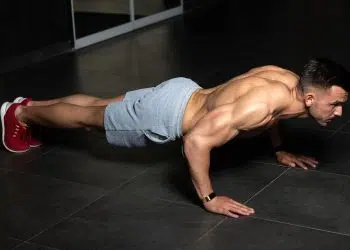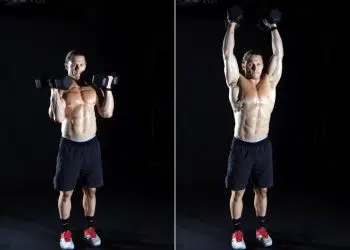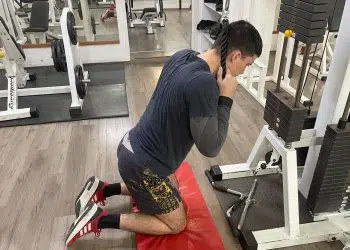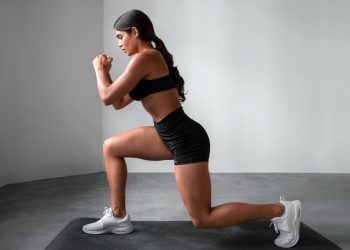While some push-ups focus on hypertrophy and strength development, variations like the shoulder tap push-up are more geared toward developing the functional aspects of physical performance. A plyometric based movement, its technique challenges not just the pushing muscles but also the core, hips and legs to keep your body stabilized and strong while one arm supports your weight.
In This Exercise:
- Target muscle group: Pectoralis (chest)
- Type: Hypertrophy, strength, plyometrics
- Mechanics: Compound
- Equipment: Bodyweight
- Difficulty: Intermediate
How To Do Shoulder Tap Push-Ups
Push-ups appear to be a simple exercise and they can be once you learn how to do them correctly. But most people do them totally wrong, or at least they aren’t getting as much benefit from them as they could be. A properly performed push-up will maximize chest muscle activation and protect your shoulders but that means your body needs to be perfectly positioned.
Here’s a checklist and detailed step-by-step instructions for the perfect push-up! Then all you’ll do is add a shoulder tap.
Learning Perfect Push-Up Technique
Before you begin, consider going through the following perfect push-up form checklist numbered in chronological steps. This will help to ensure you’re maximizing the movement and protecting your shoulders and joints. If you’re more advanced and have a solid understanding of correct exercise form then skip to the shoulder tap step.
Step 1: Hand width and placement
We all have different body types and arm lengths which usually determines the ideal hand width and placement. You want to be both comfortable yet in an ergonomic position to ensure proper body mechanics.
To find your hand width:
Level Up Your Fitness: Join our 💪 strong community in Fitness Volt Newsletter. Get daily inspiration, expert-backed workouts, nutrition tips, the latest in strength sports, and the support you need to reach your goals. Subscribe for free!
- Lie face down on the floor, reach your arms overhead and place your palms flat on the ground. Slide your palms straight down and stop when your upper arms are at a roughly 45-degree angle to your body. Keeping your palms flat on the floor, lift your elbows over your wrists and push yourself up into a high plank. Your forearms should be vertical. If they’re not then you need to adjust your hand placement.
Step 2: Setting the chest and pelvis
If you want to do a perfect push-up, your chest and pelvis need to be on the same level. Two very common push-up mistakes are letting the hips sag down causing the worm effect, and lifting the butt too high, shifting most of the load on your front deltoids.
You’ll not only waste perfectly good energy making these missteps but you’ll also waste your time!
Step 3: Scapular and head positioning
The next thing that you want to do is pull your shoulders down and back. This will create stability in your torso, support proper movement of the scapula (shoulder blades), and lead the exercise with your chest muscles.
Step 4: Bracing your core
The last step is to tighten your core muscles. Now you’re ready to do a shoulder tap push-up!
To do shoulder tap push-ups:
- From the starting position, bend your elbows and slowly drop down until your chest touches the floor.
- Press hard through your palms and squeeze your chest muscles until both arms are fully extended.
- Lift either hand off the ground and touch the opposite shoulder.
- Return your hand to its original spot then lift your other hand and touch the opposite shoulder.
- Do another push-up and repeat steps 3-4.
Watch the video example below to see a demonstration of shoulder tap push-ups.
Benefits
Why should you include shoulder tap push-ups in your chest workout rotation?
Improve push performance and upper body stability
Shoulder taps work the chest, triceps and shoulder muscles all in one. Including a tap is simply a bonus technique that forces you to activate more stabilizer muscles. Having to balance your weight on one arm will also transfer over to your single arm/unilateral (see more details about unilateral training under benefits section) presses, improving your pushing performance in these movements.
Challenge the core muscles
While core isn’t in the name, balancing on one arm in a push-up position forces your abs, obliques, and back muscles to work harder. That makes it a powerful core and total body movement. Building a solid and resilient midriff is going to make you stronger, more capable and less injury prone.
Related: Best Weighted Abs Exercises and Workouts
Unilateral component
Muscle coordination, left to right symmetrical development, improved joint stability, and stronger core muscles are all side effects of training one side of your body at a time. Unilateral training should be programmed into everyone’s workout plan because while being big and strong is a great thing, you also need to be functional and well-balanced.
When training shoulder tap push-ups, pay attention to how you feel and if both sides are equally as strong or if either is lacking.
Drawbacks
Now that we went over the pros of shoulder tap push-ups, it’s only fair to mention any potential cons.
Not beginner-friendly
Push-ups, in general, aren’t necessarily a beginner exercise. Although it really depends on someone’s starting strength and bodyweight. But it’s nothing a few months of serious training can’t fix. After you’ve developed sufficient upper body strength, you can progress to adding the shoulder tap for added benefit.
Level Up Your Fitness: Join our 💪 strong community in Fitness Volt Newsletter. Get daily inspiration, expert-backed workouts, nutrition tips, the latest in strength sports, and the support you need to reach your goals. Subscribe for free!
Common Mistakes
There’s a right and wrong way to do most exercises. Don’t make these mistakes when performing shoulder tap push-ups.
Using too much delts – The shoulder tap variation requires more total body stability than standard push-ups. Consequently, when someone lacks enough upper body strength, it causes them to protract the shoulders too much forward, shifting more of the emphasis on the delts and less on the chest which we don’t want.
Not focusing on the push-up – The push-up is half of the movement but oftentimes people rush through it and neglect to maintain proper exercise form because they’re too focused on the shoulder taps. Slow it down and ensure the muscles are working to complete the movement.
Tapping too quickly – Some people perform the shoulder taps so fast that they break proper push-up form and fail to benefit from the functional aspect of the movement. You don’t need to be slow like molasses but go at a moderate pace.
Variations
Shoulder tap push-ups can turn an average push-up workout into a functional total body movement. These variations are similar but offer their own unique benefits and advantages.
Feet elevated shoulder tap push-ups
If you’ve become proficient with the basic shoulder tap push, you can increase the load on your chest by elevating your feet on something like a block, bench, chair, etc. The higher your feet, the harder the push-up. So start with a shorter object.
Clap push-ups
Tap push-ups target the core muscles and upper body stabilizers while clap push-ups are an explosive plyometric variation. Athletes can especially benefit from this push-up because it has real world application in sports-based activities where explosive upper body power is needed.
Single arm push-ups
Single arm push-ups have all the benefits of taps plus much more. But keep in mind, it’s several levels more difficult too. That’s because you’re balancing on one arm from the beginning to the end unlike the latter. So you’re stabilizers have to shift into overdrive during the single arm push-up variation.
Inner pec or rotating push-ups
While they share many similarities, the inner pec push-up involves arm adduction (when the arm moves cross body) while shoulder taps don’t. Adduction gives you that intense squeeze in the pecs that you don’t get with most push-up variations.
For complete chest development, you should be incorporating adduction along with your pressing movements to maximize stimulation and possibly overall development of your pecs.
To do inner pec push-ups:
- Set up to do a push-up as you would normally.
- Drop your chest to the floor and as you push back up, rotate your upper body to the left while keeping both hands on the platform. You should instantly feel more of a contraction in the left pectoral muscle.
- Drop back down into a push-up and repeat the press and rotation to the right side.
- Alternate push-ups twisting to the left and right.
Push-up and reach under
A similar but harder variation is to perform a push-up and then reach under your body. It’s a logical progression from shoulder tap push-ups because you get a little more core activation and stabilization.
To do it:
- Perform a basic push-up then reach under your body and through to the opposite side. Return to the push-up position, do another push-up then reach under with your other arm.
Try This Beastly 30-Day Core Workout To Get Jacked and Strong
How Many Sets and Reps?
The optimal sets and rep range is relative to an individual’s level of training experience and goals. You’ll ultimately have to determine the best workout structure for you but we also like to offer some recommendations to help guide you. With shoulder tap push-ups, your bodyweight is the resistance so you have to program your training accordingly.
- We recommend 2-4 sets to muscular failure or just one to two reps shy.
Muscles Worked
Shoulder tap push-ups involve nearly every skeletal muscle in the human body from your head down to your toes. But it’s the muscles from your waist up that do most of the heavy pushing. After all, it’s still a push-up variation.
- Pectoralis Major Sternal Head – Also known as the lower chest, the pectoralis sternal head is a separate section of muscle fibers that assist in pulling the arms downward.
- Pectoralis major clavicular head – clavicular or upper portion of the chest causes flexion of the extended arm.
- Triceps brachii – The triceps is a three-headed muscle on the back of the upper arms. They primarily function to extend the elbow and help support the body’s weight during push-ups, bodyweight exercises and weighted presses.
- Deltoids anterior – The deltoid anterior or front deltoids is one of the three heads that make up the shoulder muscles. This muscle is involved in arm flexion, stabilizing the arm while the deltoid lateral abducts the arms (raise the arm away from the midline of the body). It also works with the pectoralis major to flex the arm when walking.
- Deltoid lateral – The deltoid lateral located between the anterior and posterior heads is primarily responsible for abducting the arm from 15 to 100 degrees. It also helps to prevent displacement of the glenohumeral joint when the arm is pressed up against the body and under load.
- When well developed, the lateral deltoids contribute to roundness of the shoulders and upper body width.
- Core muscles – The core consists of several muscles – abs (curls the pelvis and rib cage toward each other), obliques (located on either side of the abs and rotate the torso), deeper core muscles (transverse abdominis and internal obliques draw the belly button to the spine and stabilize the trunk), back extensors (allow us to stand up straight from a bent-over position and lean backward). If you want to do single arm push-ups your core needs to be fully activated.
Bottom Line
If you’ve become bored of standard push-ups or are just looking to add another chest exercise to your push day workout rotation, shoulder tap push-ups are a must. It’s a plyometric variation that adds a core stability requirement by removing the use of one arm at the top of press out, forcing your chest, tris, delts and abs to work overtime.
It may look easy if you’re already accustomed to doing push-ups but see if you still feel that way after giving a try!
Interested in measuring your progress? Check out our strength standards for Push Ups.











